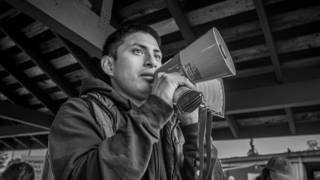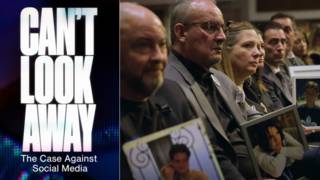
Guests
- Bryan Stevensonan attorney who has worked on death penalty cases in the Deep South since 1985, and the founder and executive director of the Equal Justice Initiative. Their new report is “Lynching in America: Confronting the Legacy of Racial Terror.” It is is part of their race and poverty project, which examines the history of racial injustice in America and the impact of structural poverty.
A new report has uncovered shocking details about the history of lynchings in the United States and their legacy today. After five years of exhaustive research and interviews with local historians and descendants of lynching victims, the Equal Justice Initiative found white Southerners lynched nearly 4,000 black men, women and children between 1877 and 1950 — a total far higher than previously known. The report details a 1916 attack in which a mob lynched Jeff Brown for accidentally bumping into a white girl as he ran to catch a train. In an example from 1940, a crowd lynched Jesse Thornton for not addressing a white police officer as “mister.” In many cases, the lynchings were attended by the entire white community in an area. We speak with attorney and Equal Justice Initiative founder and director Bryan Stevenson, whose group’s report is “Lynching in America: Confronting the Legacy of Racial Terror.” The EJI is calling for the placement of historical markers at sites where lynchings occurred.
Transcript
JUAN GONZÁLEZ: We begin today’s show with a new report on the history of lynchings in the United States and their legacy today. After five years of exhaustive research and interviews with local historians and descendants of lynching victims, the Equal Justice Initiative found white Southerners lynched nearly 4,000 black men and women and children between 1877 and 1950. Nearly 700 of those lynchings were previously unaccounted for.
The report details a 1916 attack in which a mob lynched Jeff Brown for accidentally bumping into a white girl as he ran to catch a train. In an example from 1940, a crowd lynched Jesse Thornton for not addressing a white police officer as “mister.” In many cases the lynchings were attended by the entire white community in an area.
AMY GOODMAN: Well, for more, we go to Alabama, one of the 12 Southern states profiled in the study, where we’re joined by Bryan Stevenson, attorney who has worked on death penalty cases in the Deep South since 1985, and the founder and executive director of the Equal Justice Initiative. The report, published Tuesday, is titled “Lynching in America: Confronting the Legacy of Racial Terror.” They’re now calling for the placement of historical markers at sites where lynchings occurred. Bryan Stevenson joins us from Montgomery, Alabama.
Welcome to Democracy Now!, Bryan. There’s a whole discussion again about states’ rights. In a moment, we’re going to talk to one of the first couples who just got married in Alabama. How does that relate to this horrific study that has been done, or a study about the horrific history of lynching?
BRYAN STEVENSON: Well, it relates very directly. I mean, you’re absolutely right that this rhetoric of states’ rights was precisely what local states asserted when the federal government began asking questions about why these lynchings were being tolerated. And in many ways, it is that dynamic that set up this era of terrorism. I mean, at the end of the Civil War, you had people who were reclaiming power from freed black people. It’s really at the beginning of the end of Reconstruction that we see violence and threats and intimidation beginning to assert itself to sustain racial hierarchy. White supremacy wouldn’t succeed if it wasn’t enforced with violence and threat and terror. And at the very beginning, African Americans were asking the federal government to intervene. They didn’t. And the states’ rights mindset really took shape during this era when thousands of African Americans were being lynched and menaced and threatened and terrorized, with no protection and with tolerance from both state and federal officials.
JUAN GONZÁLEZ: Well, Bryan Stevenson, your report also indicates a considerable difference in terms of the intensity of lynching from—not only from state to state, but from particular counties. Could you talk about that, as well?
BRYAN STEVENSON: Sure. I mean, lynching became a really social phenomenon. It became quite intoxicating. When people got this power to just abduct folks and to torture them and engage in this carnival-like atmosphere, they became, for want of a better word, bloodthirsty. And you see some of these counties where you have a lynching, and then that’s followed by two or three more in a very short period of time. And what was so traumatizing to people of color is that all people of color were the intended targets and victims of these lynchings. This was not an act assigned to someone for committing a crime. As you’ve described, oftentimes people were being lynched for no criminal accusation at all. You know, in Blakely, Georgia, an African-American man, William Little, came home from World War I wearing his uniform, and people were offended, annoyed that he had on this American uniform, and he was lynched because he refused to take it off. A black man, running to catch a train, bumps into a white girl. He’s lynched for that incident. This violence, this terror, was really aimed at sustaining racial hierarchy, keeping black people in their place. And in many ways, it was quite intoxicating. You could see whole communities getting involved in these acts of violence and really being quite grotesque about the way they carried them out.
AMY GOODMAN: You talk about the terror lynchings, terrorism. I want to turn to President Obama speaking at the annual National Prayer Breakfast last week. After he condemned the Islamic State as a “death cult,” he made this comment.
PRESIDENT BARACK OBAMA: Humanity has been grappling with these questions throughout human history. And lest we get on our high horse and think this is unique to some other place, remember that during the Crusades and the Inquisition, people committed terrible deeds in the name of Christ. In our home country, slavery and Jim Crow all too often was justified in the name of Christ. This is not unique to one group or one religion. There is a tendency in us, a sinful tendency, that can pervert and distort our faith.
AMY GOODMAN: That was President Obama speaking at the annual National Prayer Breakfast. He has very much caused a great deal of controversy with these comments. Bryan Stevenson, if you could respond?
BRYAN STEVENSON: Well, I think the president is quite right to acknowledge this history. I mean, we have never really talked about all of this destructive violence. I mean, these public spectacle lynchings that we document in our report are horrific. Ten thousand people showed up in Paris, Texas, in a carnival-like atmosphere to watch a man be tortured. Some of these executions—we have one in Dyersburg, Tennessee, where the man had his eyes gouged out. He was burned. He was mutilated. And thousands of people witnessed this. And it does speak to a very dark era in our history, and we make a mistake in this country when we don’t talk honestly and soberly about these experiences.
I mean, the whole North and West is populated with African Americans who fled to Detroit and Chicago and Cleveland and Los Angeles, not as people looking for opportunities, but as refugees from terror. And this narrative of racial difference, which was born in this era, that has created a presumption of guilt and dangerousness that too many young people of color are burdened with, is something that we haven’t adequately addressed, because we haven’t talked about these issues.
And so, I think the president is quite right to remind us of this history. We didn’t have truth and reconciliation in this country, and because of it, I think we remain haunted, even contaminated, by the disarray, the disruption, that these acts of violence have created in our national psyche, but also in our relations with one another. So I think it’s absolutely appropriate to be talking about these eras.
JUAN GONZÁLEZ: And, Bryan Stevenson, while your report concentrated on the Southern states, and obviously lynching was most intensely practiced against the African-American community, it was also widely practiced against—in the old Mexican territories that were the United States, like Texas and New Mexico, Arizona. I’ve seen one report where as many as 600 Mexicans were lynched between 1848 in 1928 in the old—in the Southwest. I’m wondering if, particularly in Texas, which you studied, you came across many of those incidents, as well.
BRYAN STEVENSON: Yes, we absolutely did, and you’re absolutely right. In our full report, we actually talk about the lynchings of Mexicans and Mexican Americans. And they had many of the features that are evident in the lynchings of African Americans. They weren’t being lynched for accusations of crime necessarily. There were Mexicans that were lynched for speaking Spanish in settings where people didn’t want to hear Spanish. People were lynched for celebrating Mexican holidays. And you’re absolutely right. In the border states, in particular, this phenomenon of lynching directed at Mexicans and Mexican Americans was a very real threat.
And so, this idea that racial difference can make you a target of violence and terrorism is something that we’ve been dealing with for a very long time, and I think we just haven’t really talked about it. And one of the things we want to do by erecting these markers and monuments is to get communities to begin to reflect more soberly on what this history represents. You go to Germany now, and you are forced to deal with the legacy of the Holocaust, because there are markers and monuments everywhere. We do the opposite in this country. We celebrate the things, in my judgment, that we probably shouldn’t be celebrating. In all of these states, you find Confederate memorials and monuments everywhere, dedicated to the people who were defending slavery, trying to preserve slavery, and yet nothing about the pain and anguish and suffering and injustice that those institutions created.
AMY GOODMAN: Tell us the story, Bryan Stevenson, of Jesse Thornton and Thomas Miles and others.
BRYAN STEVENSON: Yeah, Jesse Thornton was an African-American man in Luverne, Alabama. And in 1940, which is really toward the end of the lynching era, he addressed a police officer by his name. He didn’t use the term, the title, “mister.” And that was considered such a violation of the racial norms and values, that the officer organized a mob, and they lynched him.
There were people who were lynched for going up to the front door. A man in Aberdeen, Mississippi, knocked on someone’s door in the front, and then he was chased and ultimately lynched because he didn’t go to the back of the door, which is where people of color were expected to go. And about 20 percent of these 4,000 lynchings were lynchings for basically social transgressions. Many African-American men were lynched because they had notes or letters to young white women. And oftentimes people would be lynched for accusations of rape or murder, when, two or three days later, the alleged murder victim would show up in town saying, “No, I was just gone for two or three days,” or the rape victim would say, “I was never the victim of a sexual assault.”
And this hysteria was deeply, deeply disruptive to people of color. One of the things that we discovered that I was particularly moved by were people who told us that they sent thousands of people away—their relatives, their friends—because they’d have an encounter with somebody in town, and they thought the encounter might have been misinterpreted, and they feared the mob might show up, and so they would send their dad or their child or their sister or their sibling to the North, because they feared what they called a “near lynching.” And this trauma was deeply injurious. And you see evidence of that when you go into some of these communities, particularly where nobody talks about this racial history, but they celebrate the, quote, “good old days” of the early 20th century.
AMY GOODMAN: Bryan Stevenson, we’re just about to introduce the first couple in Montgomery, the first lesbian couple, to get married this week. What do you have to say to them and to Chief Justice Roy Moore of Alabama, who’s trying to put a stop to all of this?
BRYAN STEVENSON: Well, ultimately, we have got to learn to respect the rights of people who are minorities. You know, Alabama is an interesting state. There was never a time when you could get the majority of people in the state to vote to end racial segregation. In fact, our state Constitution, which is being invoked by so many people here in reference to the marriage-equality issue, still prohibits black and white children from going to school together. To change the state Constitution, you have to have a statewide referendum. We’ve tried twice now to remove this apartheid segregation language. And each time, the majority of the people in the state have voted to take that language out.
And so, what I would say to these young women is that this is a state where you sometimes have to stand when other people are sitting. It’s a place where you have to speak when other people are quiet. Courage, and courage alone, is necessary in confronting sometimes the abuse and the oppression that comes when people don’t favor you, when people don’t respect you. It’s the history of America for justice. It’s the history of the state for justice. And I embrace and applaud all who take that stand and show that courage. And I think this is a state that’s going to continually have to confront its resistance to complying with the Constitution and respecting the dignity and aspirations of all people.
AMY GOODMAN: Bryan Stevenson, thanks so much for being with us, attorney who has worked on death penalty cases in the Deep South since 1985, founder and executive director of the Equal Justice Initiative. The new report of EJI, “Lynching in America: Confronting the Legacy of Racial Terror.” This is Democracy Now! When we come back, the first gay couple to get married in Montgomery. Stay with us.
[break]
AMY GOODMAN: “Free Nelson Mandela” by The Special AKA. It was 25 years ago today, February 11, 1990, that anti-apartheid leader Nelson Mandela was released from prison after nearly 27 years. Mandela would go on to become South Africa’s first black president. This is Democracy Now!, democracynow.org, The War and Peace Report. I’m Amy Goodman, with Juan González.










Media Options